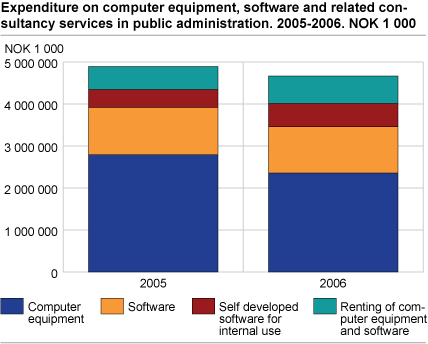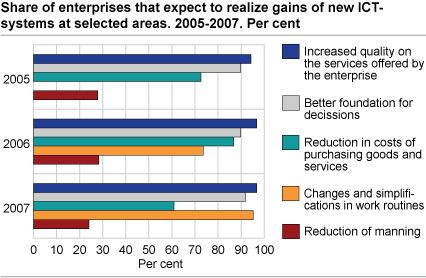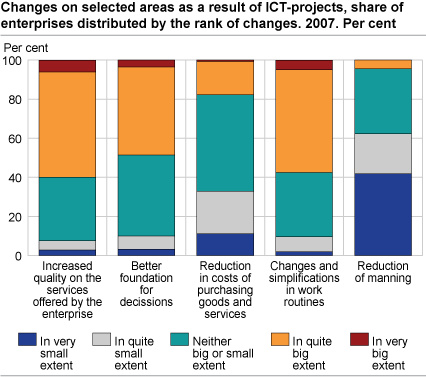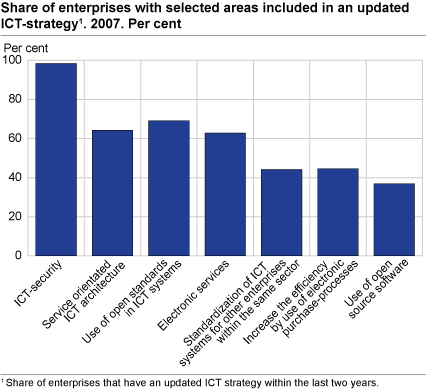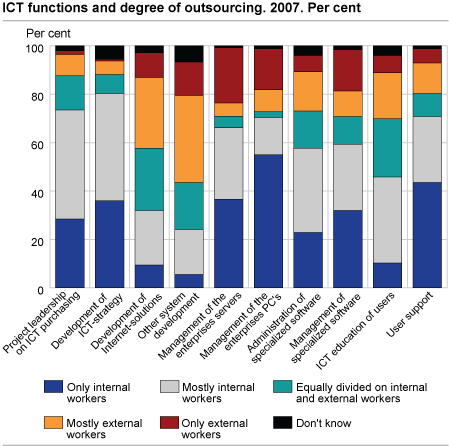Content
Published:
This is an archived release.
ICT spending NOK 4.7 billion
The public administration spent NOK 4.7 billion on ICT in 2006. Half of this went to the purchase of computer equipment and a quarter went to the purchase of software. In total, the state enterprises spent NOK 658.9 million on leasing computer equipment and software, and NOK 549.6 million on developing software for internal use.
The total cost of ICT in public administration was reduced by 4.6 per cent from 2005 to 2006. The primary cause behind this development is that the expenditure for computer equipment was reduced by 15.6 per cent. Furthermore, software expenditure was reduced by 1.9 per cent.
The expenditure for leasing of computer equipment and software increased by 20 per cent from 2005 to 2006, but only accounts for 14.1 per cent of the total ICT expenditure. The expenditure for internal software development rose by 28.9 per cent from 2005 to 2006.
Expectations and perceived changes as a result of new ICT systems
The enterprises that invest in new ICT systems expect that the new systems will result in operational benefits. Nine out of ten enterprises expect to benefit from increased quality, an improved basis for making decisions and more efficient routines. Only one out of four expects a reduction in staff.
The majority of the enterprises believe that completed or ongoing IT projects already have resulted in considerable or very considerable changes. The largest changes are seen in quality of services, basis for decisions and more efficient work routines. When it comes to changes in staffing and reduction of costs of purchasing goods and services, only 4.4 and 17.7 per cent feel that the changes have been considerable or very considerable.
ICT strategies
Only half of the enterprises in public administration have an ICT strategy that has been updated in the last two years. The survey indicates that the largest companies are slightly better than average with regard to the development and maintenance of ICT strategies. Among the enterprises that have a strategy, 98.4 per cent have included ICT security. About two out of three enterprises have included service-oriented ICT architecture, use of electronic services and open standards. Only one out of three ICT strategies includes a plan on the use of open source software.
ICT functions and extent of outsourcing
The use of external suppliers is most common in the development of Internet solutions and other types of system development, and less widespread in areas such as strategy, project management and data management. Almost half of all system developments are carried out mainly or exclusively by external suppliers. When it comes to management of the enterprises’ computers, more than half of the enterprises use their own staff only. One out of four enterprises has outsourced the management of servers to external suppliers.
In this survey, public administration is defined as enterprises within state and social administration, state business management, lenders of the state, state enterprises (wholly-owned by the state) and the Norges Bank. 584 enterprises were covered by this definition in 2007. There are substantial differences among these enterprises, also when it comes to their autonomy. A ministry or state enterprise with its own management and 500 employees is very different from a local unit placed under a ministry. These conditions also result in more uncertainty regarding ICT expenditure than in similar surveys for municipalities and county municipalities. Together these three surveys provide a good overview of the total expenditure on ICT in the public sector. |
Tables:
- Table 1 Expenditure on computer equipment, software and related consultancy services in public administration. 2005-2006. NOK 1 000
- Table 2 Share of enterprises that expect to realize gains of new ICT-systems at selected areas. 2005-2007. Per cent
- Table 3 Changes on selected areas as a result of ICT-projects, share of enterprises distributed by the rank of changes. 2007. Per cent
- Table 4 Share of enterprises with an ICT strategy updated within the last two years, by number of persons employed. 2007. Per cent
- Table 5 Share of enterprises with selected areas included in an updated ICT-strategy. 2007. Per cent.
- Table 6 Share of enterprises that offer different electronic services . 2004-2007. Per cent
- Table 7 ICT functions and degree of outsourcing. 2007. Per cent
Contact
-
Bruk av IKT i offentlig sektor
E-mail: iktstat@ssb.no

